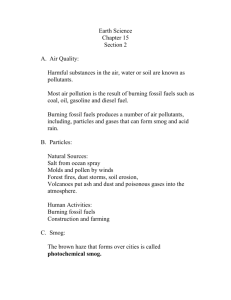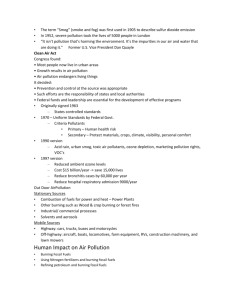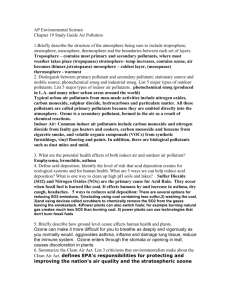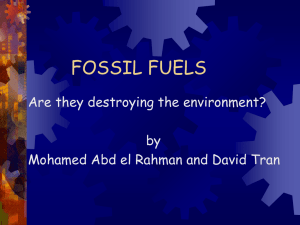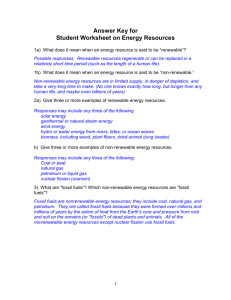(Title)
advertisement
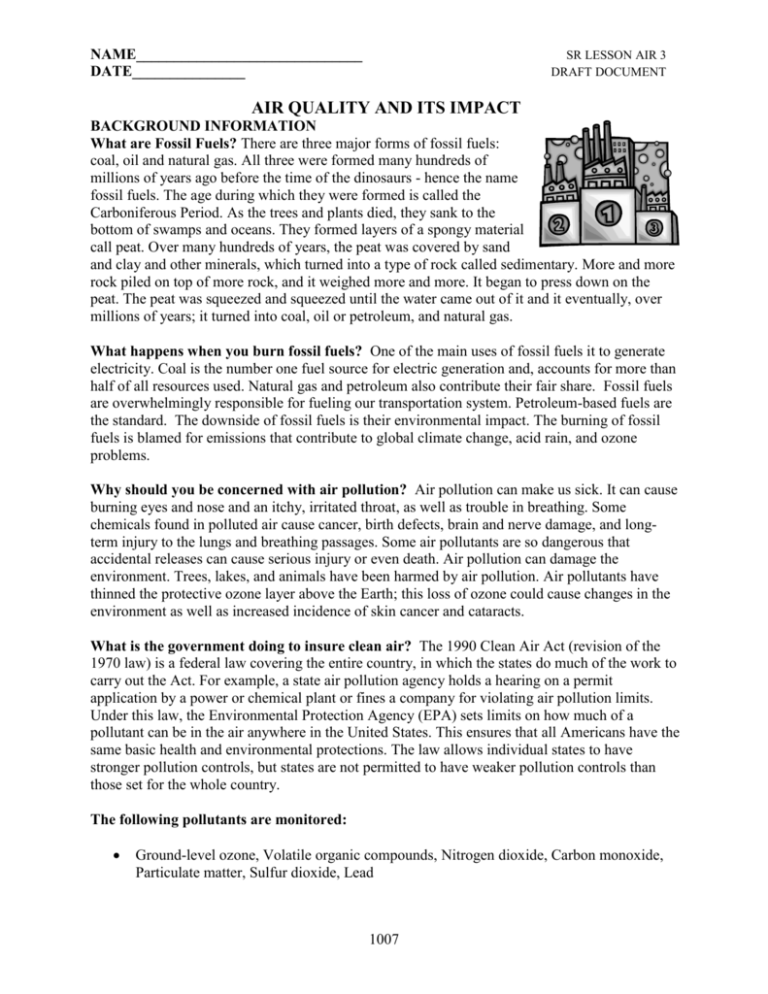
NAME______________________________ DATE_______________ SR LESSON AIR 3 DRAFT DOCUMENT AIR QUALITY AND ITS IMPACT BACKGROUND INFORMATION What are Fossil Fuels? There are three major forms of fossil fuels: coal, oil and natural gas. All three were formed many hundreds of millions of years ago before the time of the dinosaurs - hence the name fossil fuels. The age during which they were formed is called the Carboniferous Period. As the trees and plants died, they sank to the bottom of swamps and oceans. They formed layers of a spongy material call peat. Over many hundreds of years, the peat was covered by sand and clay and other minerals, which turned into a type of rock called sedimentary. More and more rock piled on top of more rock, and it weighed more and more. It began to press down on the peat. The peat was squeezed and squeezed until the water came out of it and it eventually, over millions of years; it turned into coal, oil or petroleum, and natural gas. What happens when you burn fossil fuels? One of the main uses of fossil fuels it to generate electricity. Coal is the number one fuel source for electric generation and, accounts for more than half of all resources used. Natural gas and petroleum also contribute their fair share. Fossil fuels are overwhelmingly responsible for fueling our transportation system. Petroleum-based fuels are the standard. The downside of fossil fuels is their environmental impact. The burning of fossil fuels is blamed for emissions that contribute to global climate change, acid rain, and ozone problems. Why should you be concerned with air pollution? Air pollution can make us sick. It can cause burning eyes and nose and an itchy, irritated throat, as well as trouble in breathing. Some chemicals found in polluted air cause cancer, birth defects, brain and nerve damage, and longterm injury to the lungs and breathing passages. Some air pollutants are so dangerous that accidental releases can cause serious injury or even death. Air pollution can damage the environment. Trees, lakes, and animals have been harmed by air pollution. Air pollutants have thinned the protective ozone layer above the Earth; this loss of ozone could cause changes in the environment as well as increased incidence of skin cancer and cataracts. What is the government doing to insure clean air? The 1990 Clean Air Act (revision of the 1970 law) is a federal law covering the entire country, in which the states do much of the work to carry out the Act. For example, a state air pollution agency holds a hearing on a permit application by a power or chemical plant or fines a company for violating air pollution limits. Under this law, the Environmental Protection Agency (EPA) sets limits on how much of a pollutant can be in the air anywhere in the United States. This ensures that all Americans have the same basic health and environmental protections. The law allows individual states to have stronger pollution controls, but states are not permitted to have weaker pollution controls than those set for the whole country. The following pollutants are monitored: Ground-level ozone, Volatile organic compounds, Nitrogen dioxide, Carbon monoxide, Particulate matter, Sulfur dioxide, Lead 1007 NAME______________________________ DATE_______________ SR LESSON AIR 3 DRAFT DOCUMENT OBJECTIVES Students will evaluate the impact fossil fuels have on health identify the source of pollution … by interpreting graphs and tables. MATERIALS Coffee stirrers PROCEDURE 1. Make a prediction about where you believe air pollution is worse, city (urban), suburbs (suburban), or farmland (rural). 2. Read about the criteria air pollutants and predict what type of area (urban, suburban, or rural) would have the greatest concentration of each pollutant. 3. View each of the air pollution graphs and answer the corresponding questions. 4. Answer the Extensions questions. ANALYSIS 1008 NAME______________________________ DATE SR LESSON AIR 3 DRAFT DOCUMENT PART I Nitrogen Dioxide VOCs Ozone Criteria Air Pollutants Source of pollutant Health Effects Environmental Effects chemical reaction of pollutants; VOCs and NOx breathing problems, asthma, irritates eyes, stuffy nose, reduced resistance to colds and other infections, may speed up aging of lung tissue In addition to ozone (smog) effects, many VOCs can cause serious health problems such as cancer and other effects. ozone can damage plants and trees; smog can cause reduced visibility In addition to ozone (smog) effects, some VOCs, such as formaldehyde and ethylene, may harm plants. lung damage, illnesses of breathing passages and lungs Nitrogen dioxide is an ingredient of acid rain (acid aerosols), which can damage trees and lakes. Acid aerosols can reduce visibility. VOCs are released from burning fuel (gasoline, oil, wood coal, natural gas, etc.), solvents, paints glues, and other products used at work or at home. Cars are an important source of VOCs. Burning of gasoline, natural gas, coal, oil etc. Cars are an important source of NO². 1009 Area with Greatest Concentration (Urban, Suburban, Rural) NAME______________________________ DATE Health Effects Environmental Effects Carbon Monoxide burning of gasoline, natural gas, coal, oil etc. Harms other organisms besides humans in the same manner burning of wood, diesel and other fuels; industrial plants; agriculture (plowing, burning off fields); unpaved roads burning of coal and oil, especially high-sulfur coal from the Eastern United States; industrial processes (paper, metals) Reduces ability of blood to bring oxygen to body cells and tissues; cells and tissues need oxygen to work. Carbon monoxide may be particularly hazardous to people who have heart or circulatory (blood vessel) problems and people who have damaged lungs or breathing passages nose and throat irritation, lung damage, bronchitis, early death Lead Sulfur Dioxide Source of pollutant Particulate Matter SR LESSON AIR 3 DRAFT DOCUMENT leaded gasoline (being phased out), paint (houses, cars), smelters (metal refineries); manufacture of lead storage batteries Breathing problems, may cause permanent damage to lungs particulates are the main source of haze that reduces visibility SO² is an ingredient in acid rain (acid aerosols), which can damage trees and lakes. Acid aerosols can also reduce visibility. Brain and other nervous system damage; Lead can harm wildlife. children are at special risk. Some leadcontaining chemicals cause cancer in animals. Lead causes digestive and other health problems. 1010 Area with Greatest Concentration (Urban, Suburban, Rural) NAME______________________________ DATE SR LESSON AIR 3 DRAFT DOCUMENT PART II- View each of the air pollution graphs and answer the corresponding questions. The following key applies to all of the graphs. Rural Suburban Urban Graph 1: Ozone levels 1990-2000 Time Based on the results, ____________________ has the highest amounts of ozone. The overall trend of this graph is (increasing, staying the same, decreasing). Graph 2: Nitrogen Dioxide levels 1989-1999 Time Based on the results, ____________________ has the highest amounts of nitrogen dioxide. The overall trend of this graph is (increasing, staying the same, decreasing). 1011 NAME______________________________ DATE SR LESSON AIR 3 DRAFT DOCUMENT Graph 3: Carbon Monoxide levels 1989-1999 Time Based on the results, ____________________ has the highest amounts of carbon monoxide. The overall trend of this graph is (increasing, staying the same, decreasing). Graph 4: Particulate Matter levels 1989-1999 Time Based on the results, ____________________ and ___________________have the highest amounts of particulate matter. The overall trend of this graph is (increasing, staying the same, decreasing). 1012 NAME______________________________ DATE SR LESSON AIR 3 DRAFT DOCUMENT Graph 5: Sulfur Dioxide levels 1989-1999 Time Based on the results, ____________________ and ___________________have the highest amounts of sulfur dioxide. The overall trend of this graph is (increasing, staying the same, decreasing). Graph 6: Lead levels 1989-1999 Based on the results, ____________________ and ___________________have the highest amounts of lead. The overall trend of this graph is (increasing, staying the same, decreasing). 1013 NAME______________________________ DATE SR LESSON AIR 3 DRAFT DOCUMENT EXTENSION 1. The Clean Air Act was enacted in 1990. Based on the graphs, what impact has the Clean Air Act had on air pollutants? 2. Based on your answers to the graph questions, what area is the worst to live in? 3. The average number of deaths from asthma per year in Baltimore City is 23.2 (based on data from 1998-2002). Compare this to a death rate of 12.4 in Baltimore County. Explain why there is such a difference between these two jurisdictions. What air pollutants would be to blame for the cause of asthma? What are the potential sources of these air pollutants? Base your answer on the area (urban, suburban, rural). 1014
